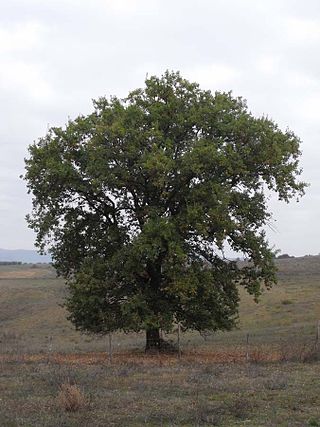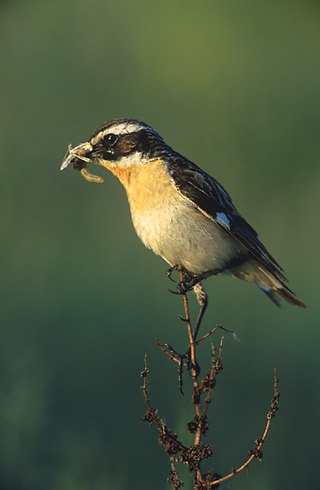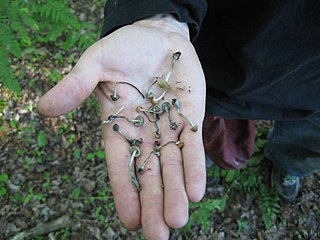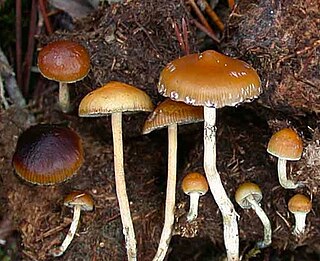
Sputum is mucus that is coughed up from the lower airways. In medicine, sputum samples are usually used for a naked eye examination, microbiological investigation of respiratory infections and cytological investigations of respiratory systems. It is crucial that the specimen does not include any mucoid material from the nose or oral cavity.

The black-winged red bishop, formerly known in southern Africa as the fire-crowned bishop, is a resident breeding bird species in tropical Africa from Senegal to Sudan and south to Angola, Tanzania, Zimbabwe and Mozambique.

Quercus pubescens, commonly known as the downy oak, pubescent oak or Italian oak, is a species of white oak native to southern Europe and southwest Asia. It is found from northern Spain (Pyrenees) and France in the West to Turkey and the Caucasus in the East.

The supercilium is a plumage feature found on the heads of some bird species. It is a stripe which runs from the base of the bird's beak above its eye, finishing somewhere towards the rear of the bird's head. Also known as an "eyebrow", it is distinct from the eyestripe, which is a line that runs across the lores, and continues behind the eye. Where a stripe is present only above the lores, and does not continue behind the eye, it is called a supraloral stripe or simply supraloral. On most species which display a supercilium, it is paler than the adjacent feather tracts.

Psilocybe quebecensis is a moderately active hallucinogenic mushroom in the section Aztecorum, having psilocybin and psilocin as main active compounds. Native to Quebec, it is the most northern known psilocybin mushroom after Psilocybe semilanceata in northern Scandinavia. Macroscopically this mushroom somewhat resembles Psilocybe baeocystis.
The elm cultivar Ulmus 'Variegata Nova' was first listed by Nicholson in Kew Hand-List Trees and Shrubs, 2: 137, 1896, as Ulmus campestris var. variegata nova, but without description. The tree was considered "possibly U. carpinifolia" (:minor) by Green.
The Duke of Bedford's vole is a species of rodent in the family Cricetidae. After the Liangshan vole was removed from this genus, the Duke of Bedford's vole became the only member of the genus Proedromys. It is found only in mountainous parts of central China. It is a rare species and the International Union for Conservation of Nature has assessed its conservation status as being "vulnerable".

The white-tailed olalla rat is a species of rodent in the family Echimyidae. It is endemic to Colombia where its natural habitat is subtropical or tropical moist lowland forests.

The Abyssinian hare is a species of mammal in the family Leporidae. It is almost entirely restricted to the nations of the Horn of Africa, though it extends marginally into eastern Sudan and may also occur in far northern Kenya.

The small lappet moth is a moth in the family Lasiocampidae. The species was first described by Carl Linnaeus in his 1758 10th edition of Systema Naturae. It is found throughout Europe and parts of Asia.

Acrolepia autumnitella is a species of moth of the family Acrolepiidae. It is found in most parts of Europe. The wingspan ranges from 11 to 13 mm. The forewings are less elongate [than in Digitivalva granitella], ochreous - brown to dark fuscous, irregularly strigulated with black and whitish; two blackish costal spots near middle; a triangular dorsal spot of whitish strigulae before middle; a black sinuate streak in disc towards apex; a whitish bar in middle of terminal cilia. Hindwings are dark grey, lighter anteriorly. The larva is whitish-green; head brownish,

Psilocybe fimetaria is a dung-loving mushroom in the genus Psilocybe. Along with Psilocybe fuscofulva, it is one of two Psilocybe mushroom species that has been found to contain no detectable levels of the psychoactive tryptamines psilocin, psilocybin, or others. In the case of Psilocybe fimetaria, this may be due to some individual specimens having a very low concentration, or the species actually being a pair of morphologically similar species.

Anania coronata, the elderberry pearl, elder pearl or crowned phlyctaenia, is a species of moth of the family Crambidae. It was described by Johann Siegfried Hufnagel in 1767 and is found in the northern parts of the Palearctic realm. It was previously also listed for the Nearctic realm. The species closely resembles Anania stachydalis.

Anania stachydalis is a species of moth of the family Crambidae. It is found in Europe. The species closely resembles Anania coronata.

Psilocybe caerulescens, also known as landslide mushroom, is a psilocybin mushroom having psilocybin and psilocin as main active compounds. Along with Psilocybe mexicana and Psilocybe aztecorum, it is one of the mushrooms likely to have been used by the Aztecs and is currently used by Mazatec shamans for its entheogenic properties.

Epinotia solandriana is a moth of the family Tortricidae. It is found in Europe, China, Korea, Japan, and Russia.

Trichiura crataegi, the pale eggar or pale oak eggar, is a moth of the family Lasiocampidae. It was first described by Carl Linnaeus in his 1758 10th edition of Systema Naturae. It is found in all of Europe, east to Anatolia and east across the Palearctic to Amur.

Opor is a type of dish cooked and braised in coconut milk from Indonesia, especially from Central Java. In Indonesia the term 'opor' refers to the method of cooking in coconut milk. Opor is a popular dish for lebaran or Eid ul-Fitr, usually eaten with ketupat and sambal goreng ati. In Yogyakarta chicken or egg opor is often eaten with gudeg and rice.

Aproaerema anthyllidella is a moth of the family Gelechiidae. It is found in most of Europe, Kyrgyzstan, Iran and North America.

Burgo is an Indonesian folded rice pancake served in savoury whitish coconut milk-based soup, flavoured with fish, and sprinkled with fried shallots. The dish is one of the regional specialty of Palembang, the capital of South Sumatra, Indonesia. In Palembang, burgo is a popular choice for breakfast. Burgo is quite similar with lakso, although lakso is thick rice noodles and its soup has yellowish color acquired from turmeric.

















